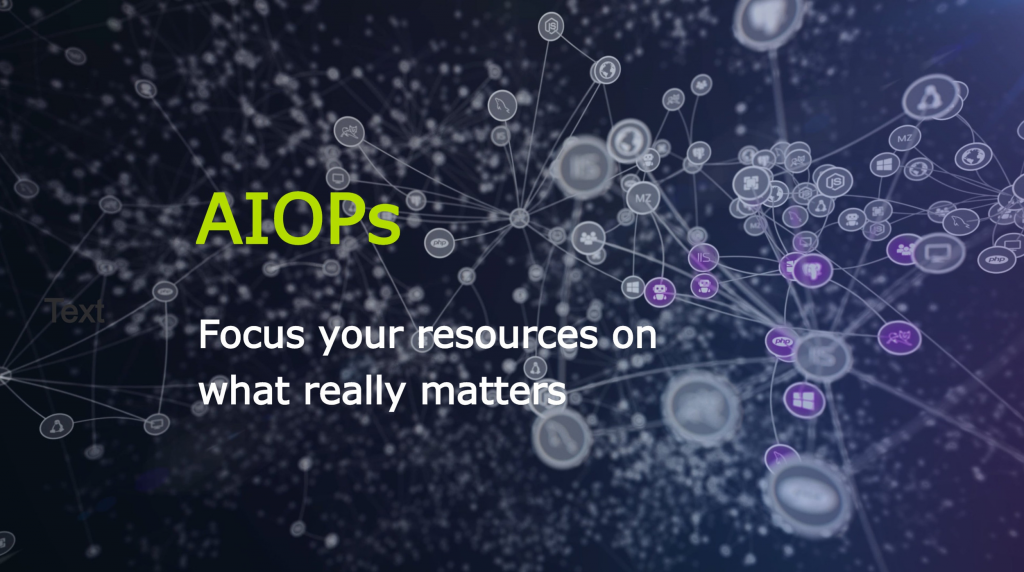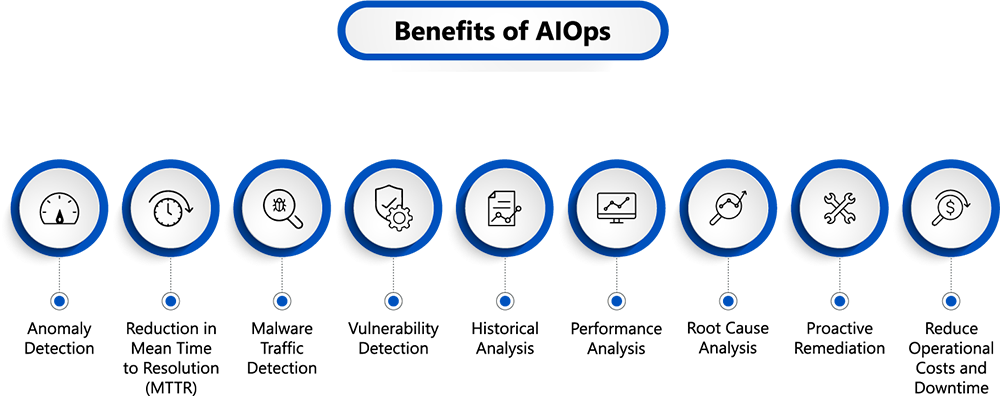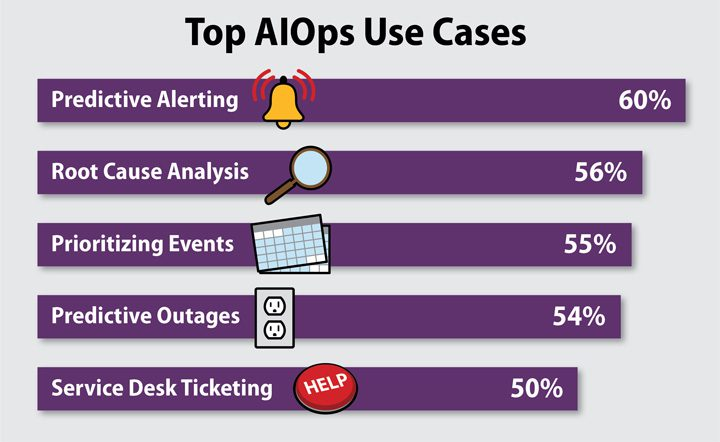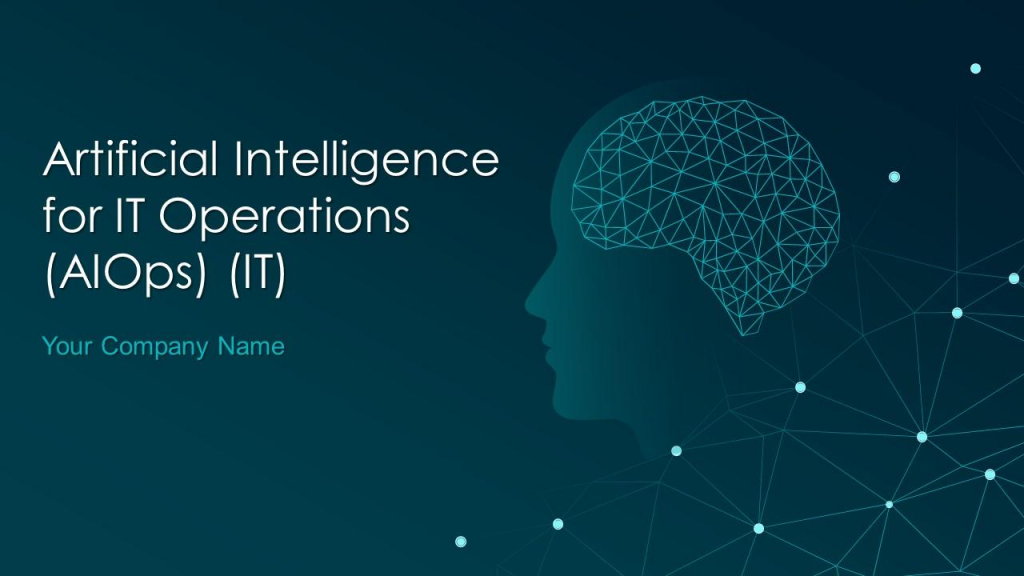
AIOps (Artificial Intelligence for IT Operations) is an approach that combines artificial intelligence (AI) and machine learning (ML) technologies with traditional IT operations practices to enhance the efficiency, automation, and intelligence of managing and maintaining IT systems, applications, and infrastructure. AIOps aims to transform how IT teams monitor, analyze, and manage complex and dynamic IT environments by leveraging AI-driven insights and automation.
The primary goal of AIOps is to enable IT teams to proactively detect, diagnose, and resolve issues, as well as optimize IT operations, by harnessing the power of AI algorithms to analyze identify patterns, vast amounts of data and make intelligent recommendations.
Key Aspects of AIOps:
- Data Collection and Analysis: AIOps involves collecting and analyzing a wide variety of data from IT systems, applications, logs, monitoring tools, and other sources. This data is used to identify anomalies, trends, and potential issues.
- Machine Learning: AIOps employs machine learning algorithms to process and analyze data, identify patterns, and learn from historical data to predict potential problems and suggest actions.
- Automation: AIOps uses automation to perform routine tasks, trigger actions based on AI-driven insights, and execute prescribed responses to incidents.
- Event Correlation: AIOps correlates data from different sources to provide a comprehensive view of the IT environment, helping to identify the root causes of issues and reduce false positives.
- Anomaly Detection: AIOps can identify abnormal patterns and behaviors in real-time, allowing IT teams to address potential problems before they cause major disruptions.
- Predictive Analysis: By analyzing historical data and patterns, AIOps can predict potential incidents and performance issues, allowing for proactive intervention.
Why Do We Need AIOps?
- Complexity of IT Environments: Modern IT environments are complex, dynamic, and often involve a mix of cloud services, on-premises infrastructure, and various applications. AIOps helps manage this complexity by providing insights and automating responses.
- Scale and Volume: IT environments generate massive amounts of data and events. AIOps can handle the scale and volume of data, making sense of it and providing actionable insights.
- Proactive Issue Detection: AIOps enables the early detection of issues and anomalies, allowing IT teams to proactively address potential problems before they impact users or services.
- Efficiency and Automation: AIOps automates routine tasks, freeing up IT teams to focus on strategic initiatives and complex problem-solving.
- Real-time Insights: AIOps provides real-time insights into the health and performance of IT systems, allowing for quicker decision-making and faster incident response.
- Root Cause Analysis: By correlating data and events from various sources, AIOps helps IT teams identify the root causes of issues more accurately, reducing troubleshooting time.
- Improved User Experience: AIOps contributes to maintaining high levels of service availability and performance, leading to an improved user experience.
- Scalability: As IT environments grow and evolve, AIOps scales to handle the increasing complexity and volume of data.
- Data-Driven Decisions: AIOps provides data-driven insights and recommendations, enabling informed decisions based on objective analysis.
- Continuous Improvement: By learning from historical data, AIOps helps improve IT operations over time, enhancing overall efficiency and reliability.
AIOps addresses the challenges of managing modern, complex IT environments by leveraging AI and machine learning technologies to automate tasks, predict issues, and provide valuable insights. It enhances the efficiency and effectiveness of IT operations, contributing to better user experiences and improved business outcomes.
What is the Advantage of AiOps?

- Proactive Issue Detection: AIOps helps in detecting and addressing potential IT issues before they impact users or services, leading to better service availability and performance.
- Automation: AIOps automates routine tasks, allowing IT teams to focus on more strategic activities and complex problem-solving.
- Efficient Incident Management: With real-time insights and automated responses, AIOps speeds up incident detection, analysis, and resolution.
- Data-Driven Insights: AIOps provides data-driven insights and recommendations, enabling informed decisions and actions based on objective analysis.
- Improved User Experience: AIOps contributes to maintaining a high level of service quality, resulting in a better user experience.
- Root Cause Analysis: AIOps correlates data from various sources to accurately identify the root causes of issues, reducing troubleshooting time.
- Scalability: AIOps scales to handle the complexity and volume of data generated by modern IT environments.
- Predictive Analysis: By analyzing historical data, AIOps can predict potential incidents and performance issues, allowing for proactive intervention.
- Continuous Improvement: AIOps learns from historical data and performance patterns, leading to continuous improvement in IT operations.
What is the feature of AiOps?
- Data Collection and Analysis: AIOps collects and analyzes data from various sources, including logs, metrics, events, and performance indicators.
- Machine Learning Algorithms: AIOps uses machine learning algorithms to process and analyze data, detect patterns, and make predictions.
- Anomaly Detection: AIOps identifies abnormal patterns and behaviors in real-time, helping to detect potential issues early.
- Event Correlation: AIOps correlates data from different sources to provide a comprehensive view of the IT environment, aiding in identifying complex issues.
- Automation: AIOps automates responses to incidents, triggering actions based on AI-driven insights and predefined rules.
- Predictive Analysis: By analyzing historical data, AIOps predicts potential incidents, allowing for proactive intervention.
- Real-time Insights: AIOps provides real-time insights into the health and performance of IT systems and applications.
- Efficiency Enhancement: AIOps automates routine tasks, optimizing IT operations and freeing up time for more critical tasks.
- Adaptive Learning: AIOps learns from historical data and adapts to changing patterns, leading to more accurate predictions and recommendations.
- Data Visualization: AIOps often provides visualizations and dashboards to present complex data in a comprehensible manner for decision-making.
- Integration with IT Tools: AIOps tools integrate with existing IT tools and platforms to streamline operations and enhance their capabilities.
- Collaboration: AIOps encourages collaboration among IT teams by providing insights and data-driven recommendations.
Overall, AIOps enhances IT operations by leveraging AI and machine learning to automate tasks, provide insights, and enable proactive management of complex IT environments. It contributes to improved efficiency, better decision-making, and a more reliable and responsive IT infrastructure.
What is the Top 10 Use cases of AiOps?

Here are the top 10 use cases of AIOps:
- Proactive root cause analysis: AIOps can be used to identify the root cause of problems before they impact users. This can help to reduce the time and resources spent on troubleshooting problems.
- Automated incident response: AIOps can be used to automate the response to incidents, such as automatically rolling back changes or deploying new configurations. This can help to reduce the time to resolution and minimize the impact of incidents.
- Improved resource utilization: AIOps can be used to improve the utilization of resources, such as servers, storage, and networks. This can aid to reduce costs and increase performance.
- Increased visibility: AIOps can be used to provide increased visibility into the IT environment. This can help to identify problems early and take corrective action before they impact users.
- Improved compliance: AIOps can be used to improve compliance with regulations, such as by automatically detecting and reporting on security incidents.
- Reduced toil: AIOps can be used to reduce the amount of manual work required to manage IT systems. This can free up IT staff to basis on more strategic tasks.
- Improved decision-making: AIOps can be used to provide better insights into the IT environment. This can help IT leaders make better decisions about how to manage IT systems.
- Improved customer experience: AIOps can be used to improve the customer experience by reducing the number of outages and improving the performance of applications.
- Increased agility: AIOps can be used to increase the agility of IT organizations by making it easier to deploy new applications and services.
- Reduced risk: AIOps can be used to reduce the risk of IT incidents by detecting and mitigating problems before they impact users.
How to Implement AiOps?
Here are the steps involved in implementing AIOps:
- Define your goals: What do you want to achieve with AIOps? Do you want to improve root cause analysis, incident response, or resource utilization?
- Gather your data: You need to collect data from your IT environment in order to train your AIOps models. This data can include metrics, traces, and logs.
- Build your models: You need to build models that can learn from the data you have collected. These models will be used to identify problems and take corrective action.
- Deploy your models: Once you have built your models, you need to deploy them into production. This will allow them to start monitoring your IT environment and taking action to prevent problems.
- Monitor your models: You need to monitor your models to make sure they are working properly. You should also tune your models over time to improve their accuracy.
- Iterate and improve: AIOps is an iterative process. You will need to iterate over the steps above to continuously improve your results.
AIOps is a complex and challenging undertaking, but it can be very rewarding. By following these steps, you can implement AIOps and achieve your goals.
Here are some additional tips for implementing AIOps:
- Start with a pilot project: Don’t try to implement AIOps across your entire organization all at once. Start with a pilot project to test the waters and see how it works.
- Get buy-in from senior management: AIOps requires a change in culture and mindset. You need to get buy-in from senior management to make it successful.
- Choose the right tools: There are many different AIOps tools available. Choose the tools that are right for your needs and that will help you achieve your goals.
- Educate your team: Your team needs to understand the benefits of AIOps and how it will affect their work. Provide them with training and resources so that they can be successful.
- Measure your results: AIOps is all about results. Make sure that you are measuring your results so that you can track your progress and make necessary adjustments.
- Be patient: AIOps is a journey, not a destination. It takes time to implement and get the most out of it. Be persistent & patient, and you will eventually attain success.
How to Get certified in AiOps?
- DevOpsSchool.com
- scmGalaxy.com
- BestDevOps.com
- Cotocus.com

There are no AIOps-specific certifications available yet. However, there are a number of certifications that can help you learn about AIOps and the technologies that are used in AIOps.
The following are the certifications that you can consider:
- Certified DevOps Engineer – Professional: This certification is offered by the DevOps Institute and covers a wide range of topics, including CI/CD, IaC, and monitoring and logging. This certification will give you a good understanding of the fundamentals of DevOps, which is essential for AIOps.
[Image of Certified DevOps Engineer – Professional logo] - Certified Kubernetes Administrator (CKA): This certification is offered by the Linux Foundation and covers the skills and knowledge needed to administer Kubernetes clusters. Kubernetes is a popular container orchestration platform that is often used in AIOps.
[Image of Certified Kubernetes Administrator (CKA) logo] - Google Cloud Certified – Professional Cloud Architect: This certification is offered by Google and covers the skills and knowledge needed to design, deploy, and manage solutions on Google Cloud Platform. Google Cloud Platform offers a number of AIOps-related services, such as Cloud Monitoring and Cloud Logging.
[Image of Google Cloud Certified – Professional Cloud Architect logo] - Amazon Web Services Certified – Solutions Architect – Associate: This certification is offered by Amazon Web Services and covers the skills and knowledge needed to design, deploy, and manage solutions on Amazon Web Services. Amazon Web Services offers a number of AIOps-related services, such as Amazon CloudWatch and Amazon CloudTrail.
[Image of Amazon Web Services Certified – Solutions Architect – Associate logo]
In addition to certifications, there are a number of other ways to learn about AIOps.
The following are the resources that you can consider:
- Books and articles: There are many books and articles available that discuss AIOps. These resources can help you learn more about the history of AIOps, the different approaches to AIOps, and the challenges and opportunities that AIOps presents.
- Online courses: There are many online courses available that teach the fundamentals of AIOps. These courses can help you learn the key concepts and principles of AIOps, as well as the tools and technologies used in this field.
- Conferences and meetups: There are many conferences and meetups that focus on AIOps. These events can be a great way to learn about the latest trends in AIOps, network with other AIOps professionals, and get hands-on experience with AIOps tools and technologies.
- Get involved in open source projects: There are many open source projects that are related to AIOps. Getting involved in these projects can help you learn about the practical application of AIOps concepts and technologies.
- Contribute to an AIOps community: There are many online communities and forums where AIOps professionals discuss their work. Joining these communities can be a great way to learn from others, get help with your own work, and stay up-to-date on the latest developments in AIOps.
The best way to learn AIOps is to find a combination of methods that works for you. Some people prefer to take courses, while others prefer to read books and articles. Some people prefer to attend conferences and meetups, while others prefer to get involved in open source projects or contribute to AIOps communities. The most important thing is to find a way to learn that is engaging and that helps you retain the information.
How to Learn AiOps?

Let’s have a look at the additional tips for learning AIOps:
- Start with the basics: Before you dive into the more advanced topics, make sure you understand the basics of AIOps. This includes topics such as data science, machine learning, and cloud computing.
- Set up an AIOps environment: Once you have a basic understanding of AIOps, you can set up your own AIOps environment. This will allow you to experiment with different tools and technologies and learn how they work together.
- Find a mentor: A mentor can be a great way to learn AIOps. They can also provide support and guidance, and they can aid you troubleshoot problems.
- Be patient: Learning AIOps takes time and effort. Don’t get demotivated if you don’t understand everything right away. Just keep learning and practicing, and you will eventually master the concepts and technologies of AIOps.
AIOps is a rapidly growing field, and there is a high demand for AIOps professionals. By following these tips, you can learn AIOps and prepare for a successful career in this exciting field.
- Degree Pursuit: Navigating the Path to Educational Excellence - July 4, 2024
- Why Is Studying English Important in a Business Environment? - July 4, 2024
- Top 10 Data Science Skills You Need in 2024 - July 3, 2024

